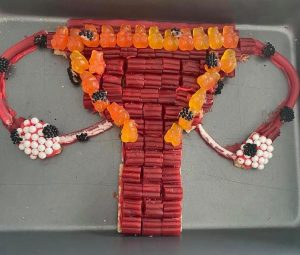We did our STEAM project on endometriosis, a disease that affects about 10% of reproductive aged women, that is characterized by the growth of endometrium-like tissue outside of the uterine cavity on areas like the ovaries, the fallopian tube, and the peritoneum. While is is benign, it is associated with chronic pelvic pain and infertility, and can severely affect quality of life. The exact cause of endometriosis is unknown, but it seems to be related to dysregulation of estrogen and progesterone, which results in progesterone resistance and estrogen dominance. For our project, we made a uterus out of licorice, gummy bears, and frosting and used candy blackberries to represent the growth of endometrium-like tissue outside of the uterus.


Soquel and AmberLynn created a model of endometriosis out of candy. They represented the presence of endometrium tissue with candy blackberries. Endometriosis is characterized by the presence of endometrium-like tissue being outside of the uterine cavity. They were able to demonstrate this condition well with their model.
Their paper went in depth as to the causes, symptoms, and treatments that exist for those with the condition. The causes are likely due to abnormal levels of estrogen and progesterone. The symptoms can range from intermenstrual bleeding, painful periods, painful intercourse, painful defecation, painful urination, and there is some correlation to fertility problems, though no definitive studies have yet been able to link endometriosis with being the cause of infertility. The treatments are only able to ease symptoms at best. Treatments can include hormone therapy, such as estrogen, progesterone, and gonadotropin-releasing hormone. Treatments can also include NSAIDS or surgery to remove endometrial patches.
There is no simple test to diagnose endometriosis. A patient’s history or abnormalities found during a pelvic exam are typically the manner in which a diagnosis starts. An ultrasound, MRI, or laparoscopy may also be conducted to narrow down endometriosis.
In Amberlynn and Soquel’s project, I can see that the candied blackberries are representing the endometrium tissue that grows on the outside of the uterus, this project is representing the objective: Describe how ovulation, menses, pregnancy, and spermatogenesis are hormonally regulated.
As the endometrium is present during menses. This project shows how the growth of endometrium affects the surrounding tissue and, in their paper, they discuss the cause of Endometriosis to be linked to dysregulation of estrogen and progesterone. Their project also shows that the growth of tissue in the wrong place can cover all of the reproductive organs. I can see how the tissue could cause pain as the excess tissue can attach to other parts of the body, such as the peritoneum which can be very painful as well as the pelvic pain caused by the excess growth in that area. In their paper, they discussed the causes of Endometriosis and noted that while it is not directly connected to infertility, Endometriosis can lead to infertility in some cases. Amberlynn and Soquel also talked about treatments that are only able to ease symptoms of pain or hormone therapy to try and regulate the hormones linked to the excess growth of tissues. There is also a surgical option to remove the excess tissue growth, but it is not a permanent fix as the growth will return. Their paper also discussed that there is not one single test to determine Endometriosis but multiple tests before a diagnosis can be confirmed if there is a suspicion of Endometriosis.